
Table of Contents
Choosing a diamond involves making several important decisions. Of the 4Cs (cut, color, clarity and carat weight), cut is considered to be the most important for colorless diamonds.
But while there are several types of diamond cuts, such as princess, round, Asscher and cushion, most of these cuts can be classified into two main cut categories – step and brilliant cuts.
These two types of cuts are very distinct, with each having its own pros and cons. They tend to appeal to different styles and tastes and provide a different aesthetic to an engagement ring.
Let’s investigate these cut types in detail.
Step vs. Brilliant Cut Diamonds
The step and brilliant cut types are the two main ones you’ll come across when searching for a diamond. Here are the diamond cuts within these two categories.
Popular Step Cut Diamonds
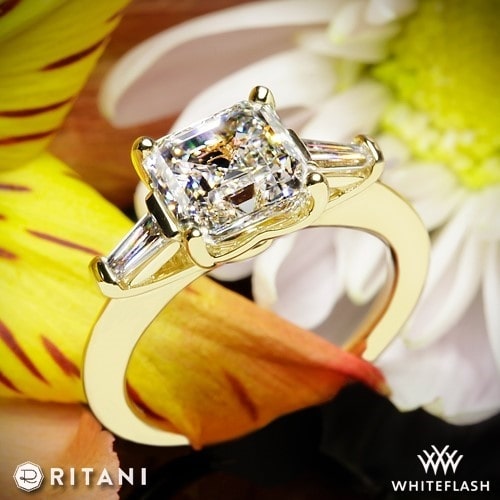
Step cuts are defined by long, open facets arranged parallel to each other. These are typically placed in a step-like fashion, graduating from the table (the large, flat facet at the top) of the diamond. Step cut diamonds are either square or rectangular in shape but may have truncated edges. The most popular step cuts are the following.
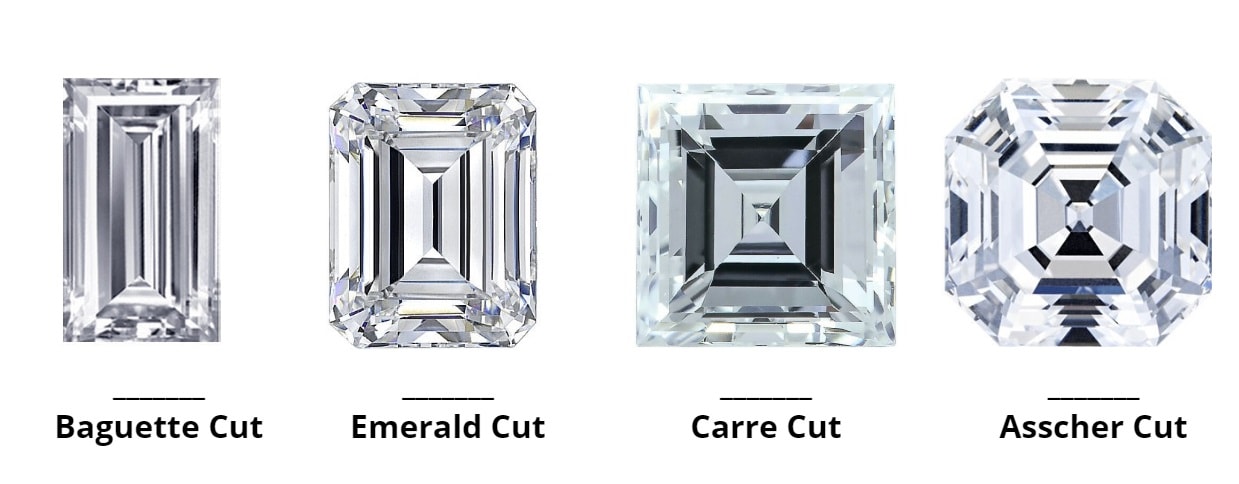
- The emerald cut is known for its long elegant rectangular shape and trimmed corners. Its beauty lies in its ability to contrast light and dark within the diamond, resulting in the hall of mirrors effect for which it is famous.
- The Asscher cut is a square cut with trimmed off corners, giving it an octagonal look. It’s characterized by the windmill design seen across its surface.
- The baguette cut is basically an emerald cut without the truncated corners. Instead, it has sharp pointed edges and a rectangular arrangement of facets. It’s typically used as accent stones. Baguette cuts don’t have much sparkle but is ideal to add detail and style to a ring design.
- The Carre cut is a more unique, relatively unknown diamond cut. It’s essentially an Asscher without the truncated corners. As such, the Carre cut doesn’t have the famous windmills of the Asscher but instead displays a clear X shape across its surface. This diamond cut is ideal if you want something very different.
It’s generally said that these four step cuts are related in that the baguette cut is to the emerald cut what the Carre cut is to the Asscher cut.
Popular Brilliant Cut Diamonds
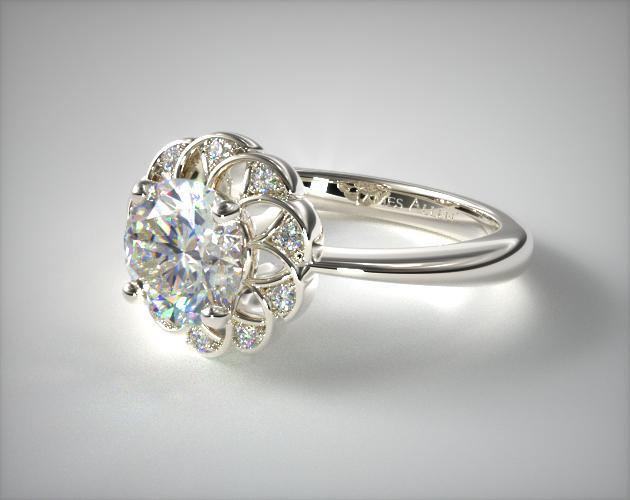
Brilliant cuts are cut in a particular manner in order to emphasize the diamond’s sparkle and brilliance. The facets are meticulously arranged to enhance the stone’s interaction with light. When viewed face up, the faceting structure of brilliant cut diamonds has a haphazard look, with facets going in every which way. This is what gives these cuts their famous sparkle.
- The round cut is the most popular diamond cut, period. Over 75% of all diamonds sold are of this cut. The round cut is versatile and suits a range of jewelry settings, with a timeless, classic look. It contains 58 facets, carefully arranged to exact precision.
- The princess cut is a square cut with sharp pointed corners. It’s the second most popular diamond cut and comes very close to achieving the brilliance of the round cut. It’s ideal for a modern look with a classical sparkle.
- The oval cut is akin to an elongated round cut, containing stunning fire and a surface that appears larger than its carat weight. It tends to have an old-fashioned feel, which makes it very popular among vintage lovers. The oval cut also elongates the fingers when set in a vertical orientation.
- The pear cut is like an oval with one pointed corner. This cut also elongates the wearer’s finger and has a stylish look. when looking for oval cut diamonds, exacting symmetry is key to finding the right stone.
- The marquise cut is like a pear cut but with two pointed corners. This gives it a very unique look, often compared to the shape of a ship. The marquise cut is a vintage cut that’s lately been resurging in popularity. It’s highly brilliant, elongates the fingers and very unique when set into jewelry.
- The radiant cut is a fairly recent cut, invented in the 1970s. It has a modern, glamorous look and is perfect for brides after a contemporary diamond cut. It’s very similar to a cushion cut, with some main differences. The radiant is so called because of its radiance and brilliance.
Differences Between Brilliant Cut vs. Step Cut
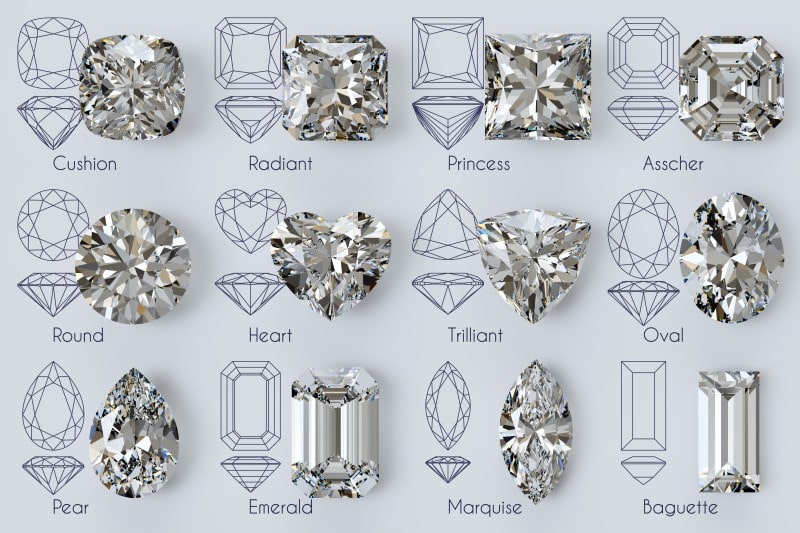
The main difference between these two types of cuts comes down to the amount of sparkle the diamond displays.
Step cuts emphasise the diamond’s clarity with a clear, open look deep into the stone. They are more passive in their beauty and have a minimalist aesthetic. While they still have very good sparkle, this is a bit more subdued.
Brilliant cuts, on the other hand, are mathematically designed to enhance the sparkle. They have more facets than step cuts, and their facets are shaped differently – typically triangular and kite shaped.
Pros and Cons of Brilliant Cut vs. Step Cut
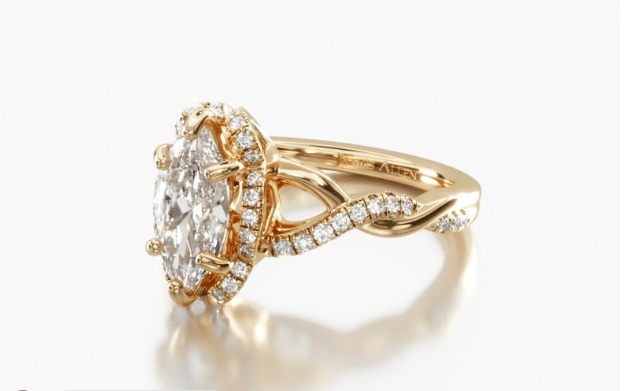
Both these cuts have their pros and cons and comparing them can be like comparing apples to oranges. If you aren’t sure which to choose, here’s a look at their pros and cons.
Step Cut
- Pros: Step cuts emphasize the diamond’s clarity, and their sleek, elegant look make them perfect for modern brides. They’re ideal for all types of jewelry settings, and especially complement Art Deco styles. They tend to be more affordable as they use up more of the diamond rough.
- Cons: Don’t choose a step cut if you want the sparkle factor. Also, you will need to focus on the quality of the diamond, as step cuts tend to show inclusions and color quite clearly.
Brilliant Cut
- Pros: It’s all about the sparkle! Brilliant cuts tend to mask inclusions and color because of their dazzling sparkle, but this varies from cut to cut. They can also make a diamond appear larger, but again, this depends on the specific cut.
- Cons: Overall, brilliant cuts tend to cost more, with the round diamond the most expensive of all.
Wrapping Up
Step and brilliant cuts both have their pros and cons. Each offers a unique type of sparkle and depth to the diamond. Which you choose comes down to the aesthetic you prefer. However, the 4cs of diamonds impact each of the diamond cuts differently, so having an understanding of this can help you choose a good quality diamond at a competitive price.









